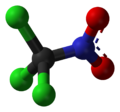| |||
| Names | |||
|---|---|---|---|
| IUPAC name Trichloro(nitro)methane | |||
Other names
| |||
| Identifiers | |||
3D model (JSmol) | |||
| 1756135 | |||
| ChEBI | |||
| ChEMBL | |||
| ChemSpider | |||
| ECHA InfoCard | 100.000.847 | ||
| EC Number |
| ||
| 240197 | |||
| KEGG | |||
PubChem CID | |||
| RTECS number |
| ||
| UNII | |||
| UN number | 1580 | ||
CompTox Dashboard (EPA) | |||
| |||
| |||
| Properties | |||
| CCl3NO2 | |||
| Molar mass | 164.375 g/mol | ||
| Appearance | colorless liquid | ||
| Odor | irritating [1] | ||
| Density | 1.692 g/ml | ||
| Melting point | −69 °C (−92 °F; 204 K) | ||
| Boiling point | 112 °C (234 °F; 385 K) (decomposes) | ||
| 0.2% [1] | |||
| Vapor pressure | 18 mmHg (20°C) [1] | ||
| −75.3·10−6 cm3/mol | |||
| Hazards | |||
| Occupational safety and health (OHS/OSH): | |||
Main hazards | Extremely toxic and irritating to skin, eyes, and lungs. | ||
| GHS labelling: | |||
    | |||
| Danger | |||
| H301, H314, H330, H370, H372, H410 | |||
| P260, P264, P270, P271, P273, P280, P284, P301+P310, P301+P330+P331, P303+P361+P353, P304+P340, P305+P351+P338, P307+P311, P310, P314, P320, P321, P330, P363, P391, P403+P233, P405, P501 | |||
| NFPA 704 (fire diamond) | |||
| Lethal dose or concentration (LD, LC): | |||
LC50 (median concentration) | 9.7 ppm (mouse, 4 hr) 117 ppm (rat, 20 min) 14.4 ppm (rat, 4 hr) [2] | ||
LCLo (lowest published) | 293 ppm (human, 10 min) 340 ppm (mouse, 1 min) 117 ppm (cat, 20 min) [2] | ||
| NIOSH (US health exposure limits): | |||
PEL (Permissible) | TWA 0.1 ppm (0.7 mg/m3) [1] | ||
REL (Recommended) | TWA 0.1 ppm (0.7 mg/m3) [1] | ||
IDLH (Immediate danger) | 2 ppm [1] | ||
Except where otherwise noted, data are given for materials in their standard state (at 25 °C [77 °F], 100 kPa). | |||
Chloropicrin, also known as PS (from Port Sunlight [3] ) and nitrochloroform, is a chemical compound currently used as a broad-spectrum antimicrobial, fungicide, herbicide, insecticide, and nematicide. [4] It was used as a poison gas in World War I and the Russian military has been accused of using it in the Russo-Ukrainian War. [5] [6] [7] Its chemical structural formula is Cl 3 C−N O 2.



